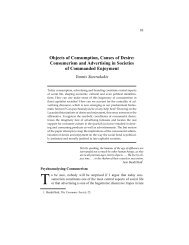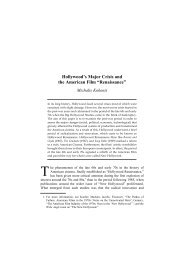19 International Symposium on Theoretical and Applied Linguistics ...
19 International Symposium on Theoretical and Applied Linguistics ...
19 International Symposium on Theoretical and Applied Linguistics ...
You also want an ePaper? Increase the reach of your titles
YUMPU automatically turns print PDFs into web optimized ePapers that Google loves.
G E N E R A L S E S S I O N<br />
Synchr<strong>on</strong>y in diachr<strong>on</strong>y: the interpretati<strong>on</strong> <strong>and</strong> analysis of in Mycenaean Greek<br />
Jeroen Vis<br />
University of Amsterdam<br />
j.vis@uva.nl<br />
In historical linguistics it is very comm<strong>on</strong> to interpret the data by means of diachr<strong>on</strong>ic rec<strong>on</strong>structi<strong>on</strong>s.<br />
In this paper I will claim that a detailed knowledge of the synchr<strong>on</strong>ic grammatical system is at least as<br />
important <strong>and</strong> provides important additi<strong>on</strong>al evidence for the interpretati<strong>on</strong> <strong>and</strong> analysis of a language.<br />
In order to support this claim, I will present a case study from the ph<strong>on</strong>ology of Mycenaean Greek<br />
(±1250 B.C.), more specifically, the ph<strong>on</strong>otactics of the labial glide . This topic is of special interest<br />
for two reas<strong>on</strong>s: a) Mycenaean raises interpretati<strong>on</strong>al questi<strong>on</strong>s due to the sparse sources <strong>and</strong> its<br />
unique orthographic system by means of syllabograms <strong>and</strong> b) the ph<strong>on</strong>otactics of glides is an issue of<br />
the <strong>on</strong>going debates in generative ph<strong>on</strong>ology (cf. Levi 2004, am<strong>on</strong>g others).<br />
Based solely <strong>on</strong> diachr<strong>on</strong>ic rec<strong>on</strong>structi<strong>on</strong>s, the c<strong>on</strong>s<strong>on</strong>ant transcribed as is usually<br />
interpreted as the semivowel [w] (cf. Ventris & Chadwick <str<strong>on</strong>g>19</str<strong>on</strong>g>72 [<str<strong>on</strong>g>19</str<strong>on</strong>g>56] am<strong>on</strong>g others). However,<br />
syllabic ph<strong>on</strong>otactics suggest a different interpretati<strong>on</strong>. In Mycenaean orthography, all <strong>on</strong>set<br />
c<strong>on</strong>s<strong>on</strong>ants are written, whereas the coda c<strong>on</strong>s<strong>on</strong>ants are omitted (Steriade <str<strong>on</strong>g>19</str<strong>on</strong>g>82, Vis 2008). Given<br />
the spelling of the words at (1), the segment participates in the formati<strong>on</strong> of the tautosyllabic<br />
clusters , <strong>and</strong> (see 1a-c), whereas the <strong>and</strong> sequences are heterosyllabic<br />
(see 1d-e). These data indicate that the c<strong>on</strong>s<strong>on</strong>antal strength of the segment is in between that of<br />
the nasal [n] <strong>and</strong> the liquids [l] <strong>and</strong> [r]. As a result, the segment should better be interpreted as an<br />
approximant [υ].<br />
The interpretati<strong>on</strong> proposed above of as an approximant [υ] implies an asymmetry between<br />
the cor<strong>on</strong>al segment [j] being c<strong>on</strong>sidered as a semivowel <strong>and</strong> the labial segment [υ] being thought of<br />
as an approximant. A closer look at the data, however, reveals that the labial <strong>and</strong> cor<strong>on</strong>al s<strong>on</strong>orants<br />
systematically display asymmetric ph<strong>on</strong>otactics. In avoiding hiatus, for example, the language exhibits<br />
several processes (see the examples in (2a-b) adopted from Vis 2008). C<strong>on</strong>sidering the result of these<br />
processes, underlying /u/ remains an aut<strong>on</strong>omous segments realized as [υ] or retains its mora as a<br />
sec<strong>on</strong>d part of a bimoraic diphth<strong>on</strong>g [Vw]. Underlying cor<strong>on</strong>al /i/ appears as a sec<strong>on</strong>dary articulati<strong>on</strong> [ j ]<br />
or as the sec<strong>on</strong>d part of a m<strong>on</strong>omoraic diphth<strong>on</strong>g [V j ], respectively. Thus, it can be c<strong>on</strong>cluded from<br />
these data that as an innate feature the labial s<strong>on</strong>orants are str<strong>on</strong>ger <strong>and</strong> more c<strong>on</strong>s<strong>on</strong>antal than the<br />
cor<strong>on</strong>al <strong>on</strong>es (see van der Torre 2003 for similar c<strong>on</strong>clusi<strong>on</strong>s for Dutch).<br />
To sum up, the knowledge of synchr<strong>on</strong>ic ph<strong>on</strong>otactics c<strong>on</strong>tributes to the interpretati<strong>on</strong> <strong>and</strong> analysis<br />
of the glide [υ] in Mycenaean Greek. Syllabificati<strong>on</strong> leads to a more accurate interpretati<strong>on</strong> of the glide<br />
as an approximant [υ], which is in harm<strong>on</strong>y with the rest of the data, as the comparis<strong>on</strong> between labial<br />
<strong>and</strong> cor<strong>on</strong>al s<strong>on</strong>orants shows.<br />
Examples:<br />
Ph<strong>on</strong>etic Orthographic Translati<strong>on</strong> Input Output Translati<strong>on</strong><br />
transcripti<strong>on</strong> transcripti<strong>on</strong><br />
1.a.[υrinos] wi-ri-no skin of an ox 2.a./ksenua/ [ksenυa] foreign (n. pl.)<br />
1.b.[υlo:ma] wo-ro-ma edge of cloth 2.c./ouk w e/ [owk w e] nor<br />
1.c.[sp h e:nυenta] pe-ne-we-ta with wedges 2.b./hikk w ia/ [hikk j a] charriot<br />
1.d.[korυos] ko-wo boy 2.d./dohelois/ [dohelo j s] slave (dat. pl.)<br />
1.e.[kalυ<strong>and</strong>ros] ka-wa-do-ro ‘man’s name’<br />
Selected references:<br />
Levi, S. V. 2004. The representati<strong>on</strong> of underlying glides: a cross-linguistic study, diss. University of Washingt<strong>on</strong>.<br />
Ventris, M. & J. Chadwick <str<strong>on</strong>g>19</str<strong>on</strong>g>72 [<str<strong>on</strong>g>19</str<strong>on</strong>g>56]. Documents in Mycenaean Greek, Cambridge: University press.<br />
Steriade, D. <str<strong>on</strong>g>19</str<strong>on</strong>g>82. Greek prosodies <strong>and</strong> the nature of syllabificati<strong>on</strong>, diss. MIT, Cambridge MA.<br />
Vis, J. 2008. Ζητήµατα από τη φωνολογία της Μυκηναϊκής Ελληνικής, diss. University of Crete.<br />
van der Torre, E. J. 2003. Dutch s<strong>on</strong>orants: the role of place of articulati<strong>on</strong> in ph<strong>on</strong>otactics, diss. Universiteit<br />
Leiden.<br />
Retr<strong>on</strong>ymy or when technology meets language<br />
George J. Xydopoulos<br />
University of Patras<br />
gjxydo@upatras.gr<br />
In this paper I discuss the sense relati<strong>on</strong> of retr<strong>on</strong>ymy. Pairs of terms like those in (1) below <strong>and</strong> their<br />
equivalents in other languages are known as retr<strong>on</strong>yms (see e.g. Fromkin et al. 2003: 185):<br />
<str<strong>on</strong>g>19</str<strong>on</strong>g> th ISTAL 61






